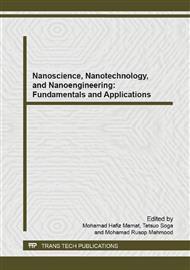[1]
V. Musteata, C. Vasile, R. Maksimovs, J. Zicans, R. Meri, and J. Bitenieks, Styrene–acrylate/carbon nanotube nanocomposites: mechanical, thermal, and electrical properties, Proceedings of the Estonian Academy of Sciences, vol. 61, p.172, (2012).
DOI: 10.3176/proc.2012.3.05
Google Scholar
[2]
F. Khelifa, M. -E. Druart, Y. Habibi, F. Bénard, P. Leclère, M. Olivier, et al., Sol–gel incorporation of silica nanofillers for tuning the anti-corrosion protection of acrylate-based coatings, Progress in Organic Coatings, vol. 76, pp.900-911, (2013).
DOI: 10.1016/j.porgcoat.2013.02.005
Google Scholar
[3]
M. Ghaemy and S. Bekhradnia, Thermal and photocuring of an acrylate-based coating resin reinforced with nanosilica particles, Journal of Coatings Technology and Research, vol. 9, pp.569-578, (2012).
DOI: 10.1007/s11998-012-9401-2
Google Scholar
[4]
A. Gergely and T. I. Török, Optimally Balanced Active-Passive Corrosion Protection by Zinc-Rich Paint Coatings Featuring Proper Hybrid Formulation with Polypyrrole Modified Carbon Nanotubes, Materials Science Forum, vol. 752, pp.275-283, (2013).
DOI: 10.4028/www.scientific.net/msf.752.275
Google Scholar
[5]
S. Jafarzadeh, A. Adhikari, P. -E. Sundall, and J. Pan, Study of PANI-MeSA conducting polymer dispersed in UV-curing polyester acrylate on galvanized steel as corrosion protection coating, Progress in Organic Coatings, vol. 70, pp.108-115, (2011).
DOI: 10.1016/j.porgcoat.2010.10.011
Google Scholar
[6]
K. Y. Lee, K. Y. Kim, W. Y. Han, and D. H. Park, Thermal, electrical characteristics and morphology of poly(ethylene-Co-ethyl acrylate)/CNT nanocomposites, Ieee Transactions on Dielectrics and Electrical Insulation, vol. 15, pp.205-213, Feb (2008).
DOI: 10.1109/t-dei.2008.4446752
Google Scholar
[7]
Y. F. Li, Z. P. Zeng, D. Wang, X. G. Wu, and L. S. Qiang, Polyaniline/Fluorocarbon Composite Emulsion Coatings for Anticorrosion to Mild Steel, Applied Mechanics and Materials, vol. 151, pp.323-326, (2012).
DOI: 10.4028/www.scientific.net/amm.151.323
Google Scholar
[8]
M. S. Shamsudin, M. R. Mahmud, F. S. Husairi, M. K. Harun, A. B. Suriani, S. Abdullah, et al., Micro-Raman, Optical and Impedance Characteristics of CNT-Substituted Acrylate/CNT Nanocomposite Thin Film, Advanced Materials Research, vol. 832, pp.286-291, (2013).
DOI: 10.4028/www.scientific.net/amr.832.286
Google Scholar
[9]
M. N. dos Santos, C. V. Opelt, S. H. Pezzin, S. C. Amico, C. E. da Costa, J. C. Milan, et al., Nanocomposite of Photocurable Epoxy-acrylate Resin and Carbon Nanotubes: Dynamic-mechanical, Thermal and Tribological Properties, Materials Research-Ibero-American Journal of Materials, vol. 16, pp.367-374, Mar-Apr (2013).
DOI: 10.1590/s1516-14392012005000175
Google Scholar
[10]
P. Vandervorst, C. H. Lei, Y. Lin, O. Dupont, A. B. Dalton, Y. P. Sun, et al., The fine dispersion of functionalized carbon nanotubes in acrylic latex coatings, Progress in Organic Coatings, vol. 57, pp.91-97, (2006).
DOI: 10.1016/j.porgcoat.2006.07.005
Google Scholar


